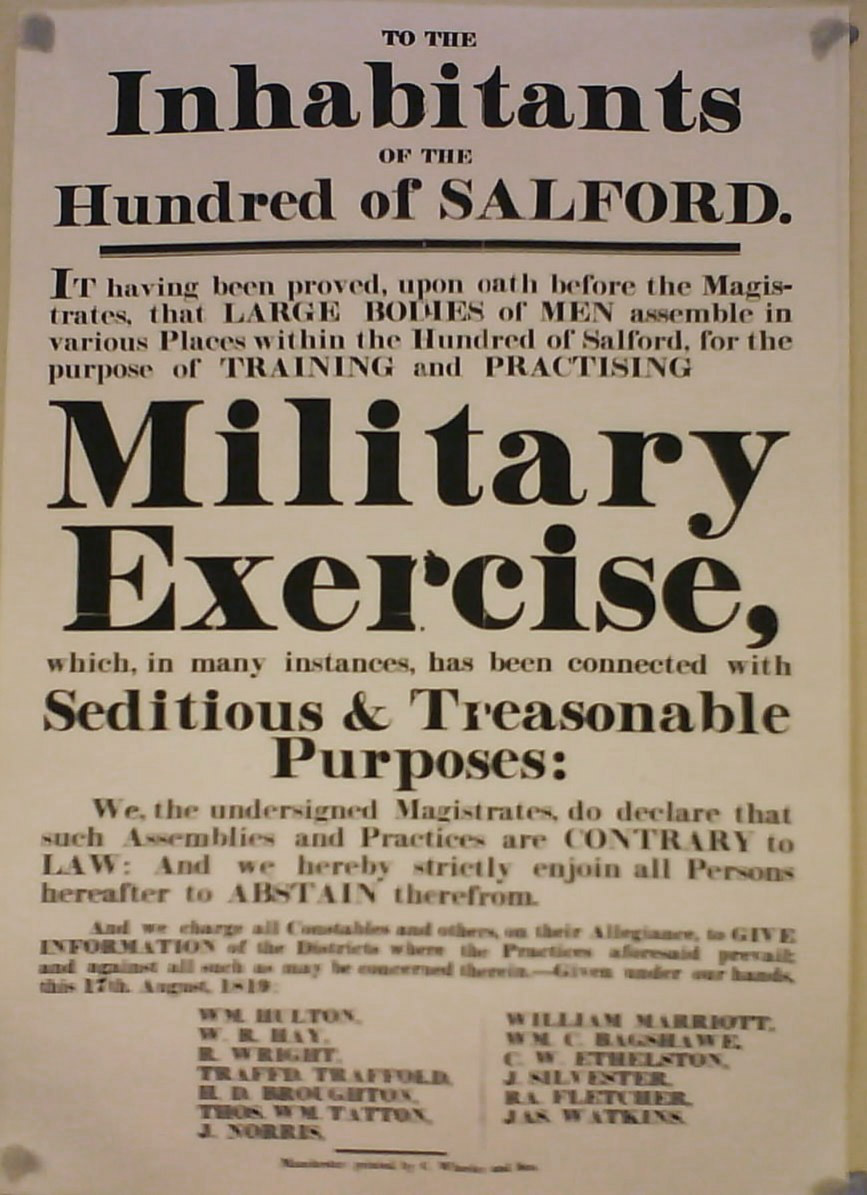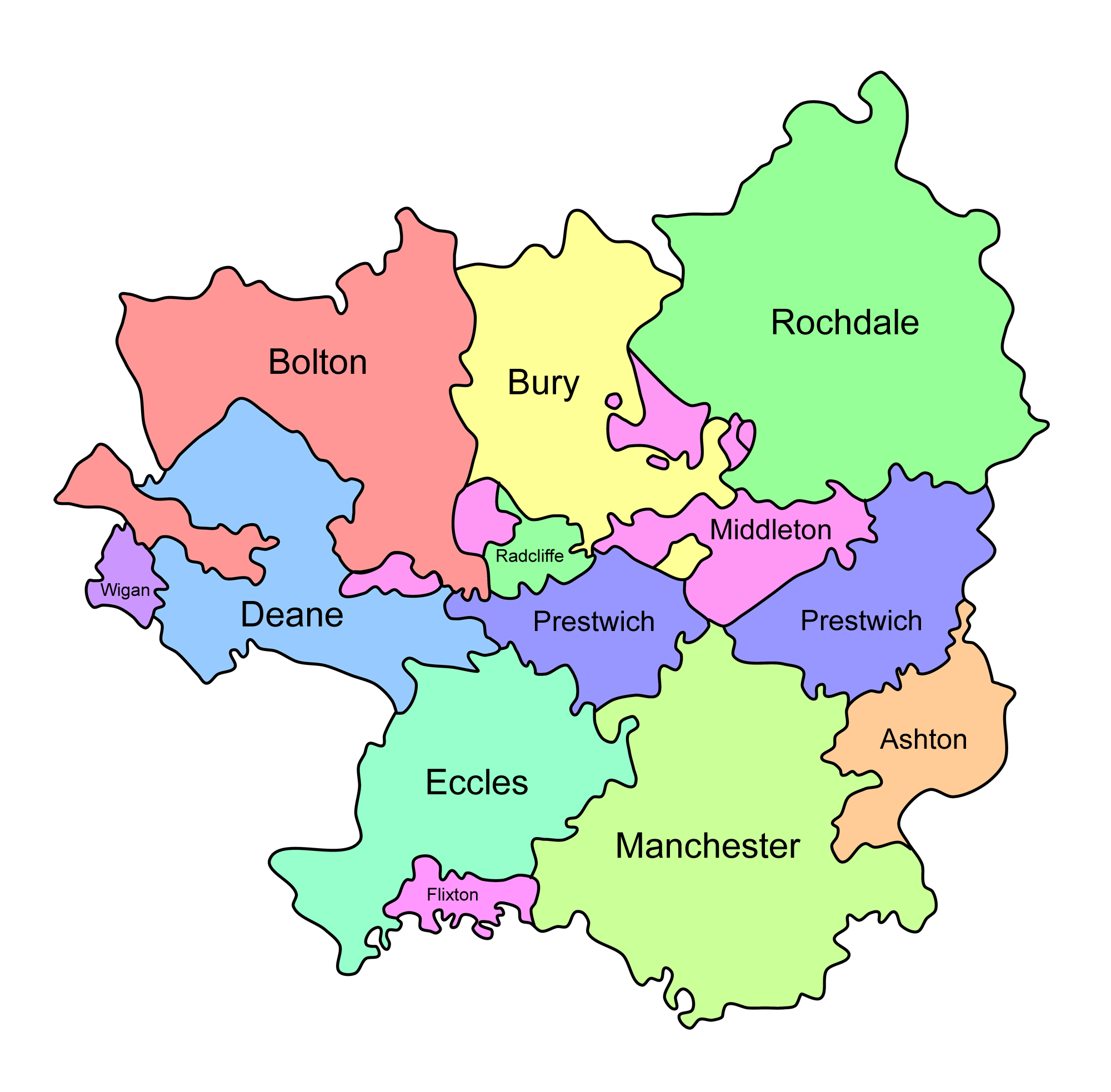Salford Hundred on:
[Wikipedia]
[Google]
[Amazon]
The Salford Hundred (also known as Salfordshire) was one of the subdivisions of the historic county of Lancashire, in Northern England (see:
 In 1846 the court was reformed to become a
In 1846 the court was reformed to become a
 The area it occupied, , corresponds loosely to the modern metropolitan county of Greater Manchester, though excludes those parts from the historic county boundaries of
The area it occupied, , corresponds loosely to the modern metropolitan county of Greater Manchester, though excludes those parts from the historic county boundaries of
Map of the Ten Parishes of the Hundred of Salford in the mid 1800s
{{DEFAULTSORT:Salford (Hundred) Hundreds of Lancashire History of Salford History of Greater Manchester
Hundred (county division)
A hundred is an administrative division that is geographically part of a larger region. It was formerly used in England, Wales, some parts of the United States, Denmark, Southern Schleswig, Sweden, Finland, Norway, the Bishopric of Ösel–Wiek, C ...
. Its name alludes to its judicial centre being the township of Salford (the suffix ''-shire
Shire is a traditional term for an administrative division of land in Great Britain and some other English-speaking countries such as Australia and New Zealand. It is generally synonymous with county. It was first used in Wessex from the beginn ...
'' meaning the territory was appropriated to the prefixed settlement). It was also known as the Royal Manor of Salford and the Salford wapentake..
Origins
The Manor or Hundred of Salford hadAnglo-Saxon
The Anglo-Saxons were a Cultural identity, cultural group who inhabited England in the Early Middle Ages. They traced their origins to settlers who came to Britain from mainland Europe in the 5th century. However, the ethnogenesis of the Anglo- ...
origins. The '' Domesday Book'' recorded that the area was held in 1066 by Edward the Confessor
Edward the Confessor ; la, Eduardus Confessor , ; ( 1003 – 5 January 1066) was one of the last Anglo-Saxon English kings. Usually considered the last king of the House of Wessex, he ruled from 1042 to 1066.
Edward was the son of Æth ...
. Salford was recorded as part of the territory of ''Inter Ripam et Mersam'' or "Between Ribble and Mersey", and it was included with the information about Cheshire
Cheshire ( ) is a ceremonial and historic county in North West England, bordered by Wales to the west, Merseyside and Greater Manchester to the north, Derbyshire to the east, and Staffordshire and Shropshire to the south. Cheshire's county t ...
, though it cannot be said clearly to have been part of Cheshire.
The area became a subdivision of the County Palatine of Lancaster (or Lancashire) on its creation in 1182.
Salford Hundred Court
In spite of its incorporation into Lancashire, Salford Hundred retained a separate jurisdiction for the administration of justice, known as the Court Leet, View of frankpledge, and Court of Record of our Sovereign Lord the King for his Hundred or Wapentake of Salford. Exceptionally for hundred courts, Salford survived until the 19th century. The lordship of Salford passed with the Duchy of Lancaster to the Crown, and a serjeant or bailiff was appointed to administer the hundred on the king's behalf. In 1436 the office of Hereditary Steward of the Wapentake of Salfordshire was granted to Sir Richard Molyneux of Sefton. The office was held by Sir Richard's successors, the Earls of Sefton until 1972. The Portmote of the Borough of Salford merged with the Hundred Court in the 17th century, and the latter body took over the administrative business of the manorial borough. In 1792 police commissioners were established in Manchester and Salford, and the Hundred Court was left with few powers. By 1828 the activities of the court consisted of the following: *A twice-yearly meeting of jury-men chose the boroughreeve
Reeve may refer to:
Titles
*Reeve (Canada), an elected chief executive of some counties, townships, and equivalents
*Reeve (England), an official elected annually by the serfs to supervise lands for a lord
*High-reeve, a title taken by some Englis ...
of Salford, along with two constables, a dog-muzzler, ale-taster and inspectors of flesh and fish for the town. The meeting also appointed constables in those townships that did not possess their own court leet
The court leet was a historical court baron (a type of manorial court) of England and Wales and Ireland that exercised the "view of frankpledge" and its attendant police jurisdiction, which was normally restricted to the hundred courts.
Etym ...
. In these townships it also possessed powers to deal with noxious smells and smoke from factories, clearing obstructions of the highway, fencing of roads, foul ditches and enforcement of weights and measures.
*A three-weekly court for the recovery of debts of less than forty shillings. These were held every third Thursday by one of three deputy stewards (usually prominent local solicitor
A solicitor is a legal practitioner who traditionally deals with most of the legal matters in some jurisdictions. A person must have legally-defined qualifications, which vary from one jurisdiction to another, to be described as a solicitor and ...
s) appointed by the Earl of Sefton.
Reform
 In 1846 the court was reformed to become a
In 1846 the court was reformed to become a Court of Record
A court of record is a trial court or appellate court in which a record of the proceedings is captured and preserved, for the possibility of appeal. A court clerk or a court reporter takes down a record of oral proceedings. That written recor ...
with its jurisdiction extended to debts not exceeding fifty pounds in value. In 1838 Manchester was incorporated as a municipal borough and granted its own court of record. The two courts were merged as the Salford Hundred Court of Record in 1869 by the Salford Hundred Court of Record Act 1868 (31 & 32 Vict. c. cxxx.). The court had jurisdiction in personal actions only.''Salford Hundred Court Inquiry'', The Times, October 9, 1951, p.8 The municipal boroughs of Oldham, Bolton, Heywood and Rochdale successively had their areas exempted from the jurisdiction of the Hundred Court by Order in Council or private Act of Parliament between 1878 and 1893.
In 1910 a committee was appointed by the Chancellor of the Duchy of Lancaster to report on the practices, area and jurisdiction of the court, and whether it was "of benefit to the parties for whose use it was intended". One member of the three-man committee recommended the abolition of the court which had "little but its age to justify its continuance", while the majority called for amending legislation. Accordingly, the Salford Hundred Court of Record Act 1911 (1 & 2 Geo. 5 c. clxxii.) was passed to restrict the area of the court to the county court
A county court is a court based in or with a jurisdiction covering one or more counties, which are administrative divisions (subnational entities) within a country, not to be confused with the medieval system of ''county courts'' held by the high ...
areas of Manchester and Salford and to alter its procedures and costs.'' The Times'', August 10, 1991, p.2
Forty years later the court was again referred to a review committee. The committee's report recommended that the court be retained as it provided "a popular and speedy remedy for a large number of litigants in the area". In 1956 the court's area was extended to encompass the entire County Borough of Stockport
Stockport County Borough was created by the Municipal Corporations Act 1835 when the existing Borough of Stockport was reformed as a municipal borough. Until 1835 the town was governed by a charter dating from circa 1220 granted by Ranulph de B ...
, which was deemed to belong to the County of Lancashire and the Hundred of Salford for the purposes of assizes
The courts of assize, or assizes (), were periodic courts held around England and Wales until 1972, when together with the quarter sessions they were abolished by the Courts Act 1971 and replaced by a single permanent Crown Court. The assizes e ...
, quarter sessions and licensing. The Court of Record for the Hundred of Salford was abolished by section 43(1)(d) of the Courts Act 1971
The Courts Act 1971 is an Act of the Parliament of the United Kingdom, the purpose of which was to reform and modernise the courts system of England and Wales.
It established the Crown Court, introduced the posts of circuit judge and recorde ...
. The last hereditary steward, Hugh Molyneux, 7th Earl of Sefton died on 13 April 1972.
Prisons
Separate places of detention were maintained for the hundred: the New Bailey Prison in Salford, which was replaced by Strangeways Prison in 1868.Constituent areas
 The area it occupied, , corresponds loosely to the modern metropolitan county of Greater Manchester, though excludes those parts from the historic county boundaries of
The area it occupied, , corresponds loosely to the modern metropolitan county of Greater Manchester, though excludes those parts from the historic county boundaries of Cheshire
Cheshire ( ) is a ceremonial and historic county in North West England, bordered by Wales to the west, Merseyside and Greater Manchester to the north, Derbyshire to the east, and Staffordshire and Shropshire to the south. Cheshire's county t ...
, as well as most of that that forms the modern Metropolitan Borough of Wigan. Its area also extended into territory north of what is now Greater Manchester, including parts of Rossendale Rossendale may refer to several places and organizations in Lancashire, England:
Places
*Rossendale Valley, a river valley
*Borough of Rossendale, a local government district
*Rossendale (UK Parliament constituency), a former parliamentary constitu ...
and Todmorden.
The parish of Manchester formed part of Salfordshire. It has been suggested that a Manchester-shire hundred was not favoured over one centred at Salford because Manchester had been ravaged as part of the Viking occupation.
The parish of Rochdale, in Salfordshire, included the chapelry of Saddleworth from the historic county boundaries of Yorkshire.
Parishes and townships
Salfordshire comprised several parishes and townships during its history. These were not static, but fragmented with the establishment of daughter churches and chapels and increases in population. The parish of Prestwich-cum-Oldham originally included the parishes of Bury, Middleton andRadcliffe
Radcliffe or Radcliff may refer to:
Places
* Radcliffe Line, a border between India and Pakistan
United Kingdom
* Radcliffe, Greater Manchester
** Radcliffe Tower, the remains of a medieval manor house in the town
** Radcliffe tram stop
* ...
, and the parish of Manchester originally included the parish of Ashton-under-Lyne. The township of Hundersfield
Hundersfield ( ; also more anciently known as Honersfield and Honnersfield) was a manor, parish and, from 1746, township, within the parish of Rochdale, in the hundred of Salford, England. It straddled the historic county boundary between Lan ...
was one of Rochdale parish's four original townships, but was itself split into four. Similarly, Prestwich-cum-Oldham was later split into two separate parishes of Prestwich and Oldham.
In 1830, Salfordshire was documented to consist of the following parishes and townships:Cooper, ''Salford: An Illustrated History'', p. 8
See also
*List of hundreds of England and Wales
Most of the counties of England were divided into hundreds or wapentakes from the late Anglo-Saxon period and these were, with a few exceptions, effectively abandoned as administrative divisions in the 19th century.
In Wales a similar Celtic sy ...
References
Notes
Bibliography
*External links
Map of the Ten Parishes of the Hundred of Salford in the mid 1800s
{{DEFAULTSORT:Salford (Hundred) Hundreds of Lancashire History of Salford History of Greater Manchester